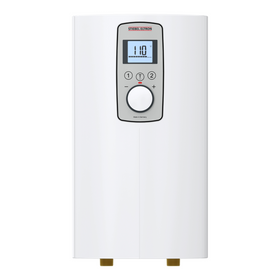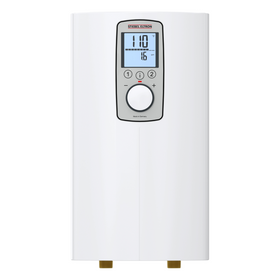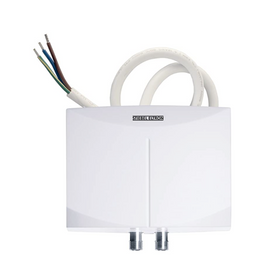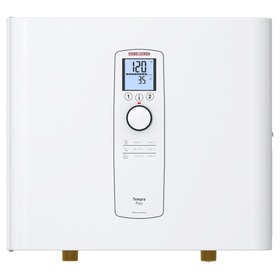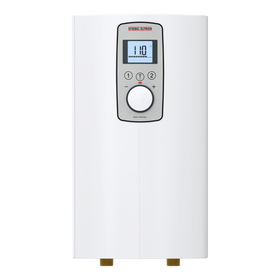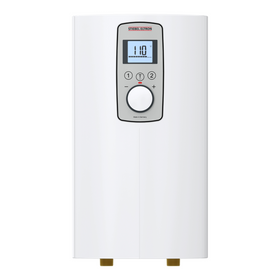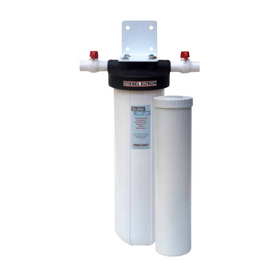
Are Drain Water Heat Recovery Systems Worth It?
Last Updated: Feb 26, 2025Enjoying a long, warm shower is a luxury that many homeowners relish. The advent of low-flow showerheads that only consume an average of around 2 gallons per minute or the Nebia Spa showerhead that offers a spa-like experience at a fraction of the water usage can help to reduce the environmental cost (and water and energy bills) of those showers.
While water-saving technology is becoming the norm in sustainable bathrooms, most homeowners never stop to think about the amount of energy that is wasted in hot water that disappears down the drains of our showers and sinks. Drain water heat recovery systems offer an innovative method to utilize this normally wasted energy.
The Energetic Cost of Heating Water
Heat-creating devices are some of the most energy-intensive appliances and devices in the modern-day home. For that reason, heat pumps are widely touted as a more energy-efficient and sustainable way to heat a home: they move heat from one place to another instead of creating heat. Similarly, heat pump clothes dryers create heat by condensing a type of refrigerant, thus reducing the laundry room's energetic cost. While moving heat instead of generating it is much more energy effective, finding ways to reutilize heat is another efficiency measure of a sustainable home.
According to the Residential Energy Consumption Survey carried out by the Energy Information Administration (EIA), “in 2015, a two-person household consumed 12.5 million British thermal units (Btu) on average, or 16 percent of overall consumption, to heat water. A four-person household consumed nearly twice as much energy for water heating at 22.7 million Btu per home, or 24 percent of overall consumption for a household that size.” The larger the size of the household, in other words, the more energy required for residential hot water needs.
Table of Contents
- Does a Gas Water Heater Produce Carbon Monoxide?
- How do Drain Water Heat Recovery Systems Work?
- What Are The Benefits Of Hot Water Heat Recovery Systems?
- Manufacturers of Drain Water Heat Recovery Systems
- What Is the Payback Period for a Hot Water Heat Recovery System?
Does a Gas Water Heater Produce Carbon Monoxide?
In terms of carbon emissions, natural gas and propane hot water systems have a carbon emissions range between 609 and 739 pounds per megawatt-hour. Electric water heaters could be more or less than that, depending on how much coal contributes to the electrical. Finding ways to reduce your hot water demand, then, will also directly translate into a smaller household carbon footprint.
While the heat generated through space heating remains in the home, especially if it is well insulated, the heat in hot water is immediately lost down the drain. On-demand water heaters are widely seen as much more energy-efficient than tank water heaters, but the generated heat from these tankless systems is also lost once the water goes down the drain.

How do Drain Water Heat Recovery Systems Work?
Drain water heat recovery systems are designed to capture that heat that is lost from the hot water going down the drain. That hot water, instead of being sent to your municipal sewer system, septic tank, or gray water recycling system, is instead used to pre-heat the cold water that enters your household water heater. A coiled copper tubing system is wound around the central copper drain tube exiting your shower or sink, thus replacing a small section of the vertical drain stack. The system's exact size will depend on your household hot water needs, though anywhere between three to four feet of vertical drain stack is usually enough to reduce your hot water energy consumption by up to 25 percent.
The hot or warm water that goes down your shower or sinks drain flows into the vertical copper tube. At the same time, cold, potable water is flowing through the copper coil that is connected to this tube. Basic heat exchange occurs as the cold water flowing through the copper coil extracts the energy from the heat that is going down the drainpipe. Subsequently, the heated water in the copper coil is directed to your water heater tank. Because the incoming water is already pre-heated, your water heater will use significantly less energy to heat and maintain your water temperature.
What Are The Benefits Of Hot Water Heat Recovery Systems?
Drain water heat recovery systems offer several benefits. Most importantly, these systems will reduce your consumption of hot water, thus lowering both your energy bill and your carbon footprint. Through lowering water heating demands, drain water heat recovery systems can prolong the life of your hot water heater by reducing its overall workload. Also, these systems are simple and reliable. They have no moving parts and thus, once installed, require virtually zero maintenance. Most drain water heat recovery systems have an estimated lifespan of over 30 years. The immediate savings you will notice on your energy bills will translate into a relatively quick payback time for this sustainable home investment.
Drain water heat recovery systems are compatible with all different water heating systems, including both tank water heaters and on-demand models. When connected to a tankless on-demand water heater, homeowners will see a significant increase in hot water flow. If your home has a more standard tank hot water heater, you will notice more hot water availability, with up to three times more hot water for showering.
Manufacturers of Drain Water Heat Recovery Systems
Below, we offer a short review of three of the leading manufacturers of these systems.*
Power-Pipe Drain Water Heat Recovery System
This drain water heat recovery system is available at most major home improvement stores. It can be used for drinking water and will extend your effective hot water capacity. This system has been designed to be used with any standard plumbing system. The 10-year warranty is an added benefit for an affordable energy efficiency upgrade to your home. According to the manufacturer, the Power-Pipe system has the ability to reduce household greenhouse gas emissions by up to 1 ton per year for a four-person household. The 48 inch Drain Water Heat Recovery Unit currently costs just under $650 at Home Depot; less expensive options are available for smaller households.
Thermo Drain
A Canadian manufacturer designs this drain water heat recovery system. The company claims that homeowners can save up to 40 percent on their hot water bills while also reducing their carbon footprint. The Thermodrain currently costs $450 for customers in most parts of Canada.
WaterCycles
WaterCycles is another Canadian manufacturer that also offers a high-quality drain water heat recovery system. Their WX-3036 residential model is made to fit a 3-inch drain pipe, is 36 inches in length, and claims to be 40.6% efficient. This model can also be adapted to households with anywhere between two and six people.
What Is the Payback Period for a Hot Water Heat Recovery System?
Drain water heat recovery systems are simple innovations that can bring major benefits to any home, but you need to hire qualified plumbing and heating professionals for the job. While installation can be less expensive for new home construction, it can still be installed in existing homes—and the payback, according to the U.S. Department of Energy, ranges from 2.5 to 7 years.
So the next time you look at your energy bill and ask, “how can I reduce this?” consider a drain water recovery system—because why waste the heat that you already paid for?
Tobias Roberts
Tobias runs an agroecology farm and a natural building collective in the mountains of El Salvador. He specializes in earthen construction methods and uses permaculture design methods to integrate structures into the sustainability of the landscape.




